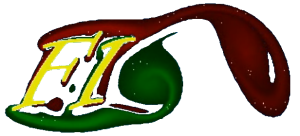Our server transforms the picture into numbers suitable for input to a code, a Navier-Stokes solver, which, by stepping in time, solves the equations governing the flow past the object. It then converts the numerical solution back into a graphical form and composes the frames into a video. Flow Illustrator is optimised for speed and robustness, with accuracy being traded in. Treat the videos as artist impressions.
How it works in more detail
The Navier-Stokes equations are solved on a grid coinciding with the pixels in the bitmap. This means that the accuracy of the calculation improves as the number of pixels increases. However, the time needed to calculate the video also increases. In practice, in most cases this will not allow obtaining accurate results. However, the video might look right anyway, after some trial and error with the value of Re.
The grid is Cartesian, and the body (that is the solid object) is modelled using a simple version of the immersed-boundaries method. This is similar to assuming that the body is porous, so that the fluid can flow through it, but very slowly. Normally it will not be noticeable in the video, except the cases when the body is very thin.
The convective terms are modelled with upstream finite differences. This makes the method very stable, but not very accurate. The viscous terms are modelled using second-order in space and first order in time implicit finite differences. This, too, makes the method very stable, but not very accurate.
